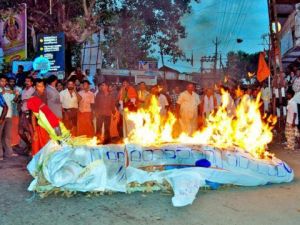Rose Bridger
21st November 2013
One of many protests against a greenfield airport at Aranmula. Photo: Aranmula Paithruka Grama Karmasamithy.
Rural communities all over India are battling against a land grab of epic proportions. And one of the biggest causes of land grabs is for airports to support India’s domestic aviation boom. Rose Bridger reports from Kerala, where four new ‘green field’ airports are meeting stiff local resistance.
The government is pulling out all the stops to support domestic aviation growth.
On a massive scale, large tracts of farmland and wildlife habitats are being handed over to corporations for mines, steel plants, manufacturing, agribusiness plantations, roads, dams, oil refineries, power plants and logistics parks.
A failed model of development is being imposed at breakneck speed, based on fossil fuel dependency and maximising extraction and consumption of resources.
The land grab has been met by tumultuous protests by people defending their land and livelihoods. Compensation is often negligible, subject to lengthy delays, or even non-existent. Rehabilitation programmes are similarly inadequate. All too often, evictees are left destitute – granted neither new plots of land and housing comparable to what they have lost, nor employment at the project that displaced them.
Affected communities also have concerns beyond their own future. Loss of wildlife habitats and biodiversity is of such a monumental scale that entire ecosystems are destroyed. Encroachment onto farmland reduces food supplies, in a country where one in five citizens go hungry.

PHOTO: One of many protests against a greenfield airport at Aranmula. Photo: Aranmula Paithruka Grama Karmasamithy.
One important aspect of the land grab is airport expansion, and new airports. There are ambitious projects at various stages of planning, approval and construction all over India. New airports on undeveloped sites, are called ‘greenfield’ airports. The requisite road network and associated land developments often extend the airport footprint over a far wider area.
Three greenfield airports are planned in Kerala, one of the smallest states in India – at Aranmula, Wayanad and Anakkara. All three sites consists of biodiverse wetlands and paddy fields where farmers cultivate rice and other crops. Plans for a proposed airport at Aranmula encompass four villages – Aranmula, Mallappuzhasserry, Mezhuveli and Kidangannur.
Fertile, biodiverse wetlands which would be paved over are surrounded by densely forested hills, which would be levelled off. More than 40 hectares have already been filled in, using earth from a nearby hillock.
Satellite images show the pale brown strip in sharp contrast to the vast expanse of lush green surrounding it. The disruption caused to irrigation and flood control is an indication of the disastrous ecological consequences should the airport be built.
About 3,000 families may face eviction. The campaign against the airport is led by the Aranmula Heritage Village Action Council and there have been major protests for more than two years, including rallies, fasting, an attempt to storm into the developers’ office and a human chain of hundreds of people.
Reputable organisations report that claims by the developer, KGS Group, to be in legal possession of the land are false, and that granting of clearances by government agencies, for filling in of wetlands and other development activities, is fraudulent and illegal.
Supposedly, the new airport would bring in more tourists. But it would destroy much of what is attractive to visitors. Aranmula has been declared a global heritage village by UNESCO. It is renowned for metal mirrors made from unique clay and an annual snake boat regatta along the Pampa River. The runway would be less that 1 kilometre from Aranmula’s famous temple, visited by pilgrims from far and wide. Aircraft noise would not be conducive to peaceful contemplation.

PHOTO: A protest against Wayanad airport. Photo: Krishibhoomi Samrakshana Samithi. The writing translates: ‘Remove the proposed Wayanad (Cheekkalloor) airport project. This project will replace the paddy fields, wiping out farmers, farm labourers, ordinary people and tribes, by destroying drinking water and food’
Proposals for an airport at Wayanad are being vigorously opposed by 200 farmers from the villages of Cheekkalloor, Eranelloor and Mechery. The 200 hectare site yielded 526 tonnes of rice last season. Farmers also cultivate many other crops including coffee, cardamoms, coconut, palm, tapioca and medicinal plants. The area is a sanctuary for migratory birds.
As with the Aranmula project, the airport would require bulldozing of hills, plus removal of trees and shrubs. Villagers have blocked officials from entering the site to conduct surveys and burned a misleading pamphlet promoting the development. Most recently, on 11th October, about 1,000 farmers and agricultural workers participated in a march against the project.

PHOTO: An airport in Anakkara would pave over rice fields. Photo: saveanakkara.com
Plans for a greenfield airport at Anakkara are remarkably similar to the Aranmula and Wayanad projects. The 200 hectare site is important for food production, one of few remaining paddy fields in the district planted with incresingly rare indigenous varieties of rice. Other crops such as peppers, vegetables, coffee and cardamoms are cultivated. The Save Anakkara Forum is fighting against the scheme. About 6,000 families would be evicted and there is no rehabilitation plan.
The two proposed airports at Anakkara and Wayanad are intended to provide connectivity with a hub airport. The industry term for this is a ‘feeder airport’, which is ironic, as, if the projects go ahead, farmland will be paved over and the loss of productive farmland will be irrevocable.
Plans for second airports for two major cities, Goa and Mumbai, on greenfield sites, have been delayed by farmers’ resistance to land acquisition for over a decade. Land acquisition for a second airport for the tourist magnet city of Goa, at Mopa, is displacing farmers cultivating rice, lentils, mangos and cashew nuts. People from 12 villages lost a court hearing over land acquisition in January. But they continued farming the land and uprooted yellow markers designating it as airport property.
The proposed second airport in Mumbai, at Navi, threatens to encroach on agricultural land and remove swathes of mangroves, which are the foundation for unique coastal ecosystems and protect inland areas from flooding. In October, the Bombay high court permitted clearing over 160 hectares of mangroves and 400 hectares of mudflats for the airport.
Expansion of existing airports also requires large tracts of land, causing turmoil in neighbouring communities, including at Birsa Munda, Imphal and Chennai. Protests against Birsa Munda Airport’s expansion over fertile land have involved hundreds, sometimes thousands, of people since 2007. In September 2012 security could not prevent a small group of displaced villages from entering the site with cattle and ploughs, and digging up plots of land they claimed still belonged to then.
Expansion of Imphal Airport has displaced over 100 settlements since 1960, yet much of the land remains unutilised inside the airport fence. In 2008, agitation by affected villagers culminated in pitch battles with police.
Over 5,000 people, including farmers who have cultivated rice for five decades, have been affected by land acquisition for a parallel runway for Chennai Airport. The runway plan has been dropped, and the United People’s Forum for Survival is campaigning for the land to be denotified without delay.
With expansion of Chennai Airport stalled, a proposed greenfield airport at Sriperumbudur, just 30 kilometres away, is back on the agenda. The site spans over 18 square kilometres, predominantly agricultural land with several lakes. In August 2010, 3,000 people from 26 villages demonstrated against the scheme, and police attacked them with a baton charge.
A farmers’ movement against a greenfield airport in Bellary also met with a police baton charge, when they formed a road block in 2009. Land earmarked for the Bellary project, in the villages of Chaganur and Siriwar, was fraudulently categorised as ‘barren’. In fact, the land was fertile and farmers harvested two crops per year and paid taxes for irrigation.
Here hundreds of agricultural workers protested, fasting and performing a mock funeral of the government land acquisition notice. In 2012, a group of Bellary farmers made a successful appeal to the High Court to have the land denotified, and urged the government to allot the land to a co-operative society of landless labourers, for them to recultivate it.
In June, India’s central government put both Bellary and Sriperumbudur airports back on the agenda, and expedited a fourth international airport in Kerala, on a greenfield site in Kannur. The Kannur project is barely 75 kilometres aerial distance from the paddy fields earmarked for an airport at Wayanad. Land acquisition disputes have dogged the project, and more than 30,000 trees are to be felled.
Situated on a site of over 8 square kilometres, the airport will be surrounded by golf courses, business parks, logistics facilities and a convention centre. The key to this airport centric urban form, the ‘aerotropolis’, is that the airport owns the land around it and generates non-aeronautical revenue from its development.
India’s first aerotropolis, Andal, met with forceful opposition since land acquisition commenced in 2009. Farmers stormed government offices, uprooted fencing and marked out their land with bamboo poles that they guarded round the clock.
Andal is now operational, but ongoing agitation has resulted in the project area being reduced from 12 to 9.7 square kilometres. The runway is restricted to helicopter flights because 400 farmers refuse to part with land to move electricity pylons out of the way.
The primary objective of India’s greenfield airport programme is to increase domestic flights. These journeys could be substituted by improving the road and rail network, slower than travelling by plane, but resulting in far lower carbon emissions.
When GS Bawa, General Manager of Airports Authority of India, approved 15 greenfield airports in October, he stated that the new airports would ‘provide improved air connectivity to Tier- & Tier-3 cities’. He described the projects as ‘feeder airports’, to generate traffic for underutilised airports and reduce traffic for busy ones.
The government is pulling out all the stops to support domestic aviation growth. In April, the aviation ministry announced that, in order to increase traffic to 89 towns with small airports, for regional air connectivity, state governments would be expected to provide free land and all airport infrastructure, and to waive property tax and reduce fuel tax for domestic flights.
The West Bengal government moved quickly to reduce fuel tax, slashing it to zero for a three year period at Andal and Bagdogra, another domestic airport. Other state governments are anticipated to follow suit.
Without this raft of subsidies, it is likely that new airports will languish under-utilised or even empty. India already has airports with no flights. Of 115 airports run by the Airports Authority of India (AAI), 44 are not operational, the majority closed because they are not economically viable.
CAPA (Centre for Aviation), a respected aviation industry consultancy, is doubtful about the feasibility of planned airports’ traffic projections, stating that “all too frequently they seem to be floated without taking into account whether there is a market that can support viable air services”. Furthermore, CAPA says that “In certain cases, regional airports appear to be exercises in securing land for commercial activity.”
Land acquisition for airports and associated development progresses inexorably, based on unreliable air traffic projections. The only certainty is that converting land from agricultural to industrial use increases its commercial value.
Farmland is being converted to real estate. Thousands of people all over India are occupying their own land against an aggressive aviation land grab. The examples in this article are a small fragment of a nationwide picture.
From my own research I am aware of about 50 sites where communities are resisting being wiped off the map. Their struggle is relevant to campaigns concerned with land rights, food sovereignty, ecological protection, social justice and governance.
Rose Bridger (@RoseKBridger) is the author of Plane Truth: Aviation’s Real Impact on People and the Environment, published by Pluto Press. Her website is at http://rosebridger.com.
The book may be bought at http://bit.ly/16Q6bw8.

